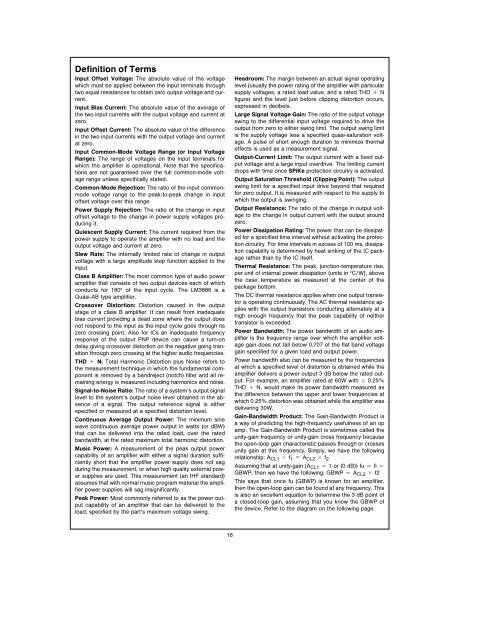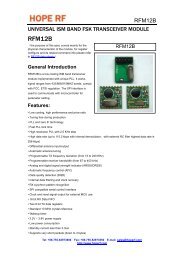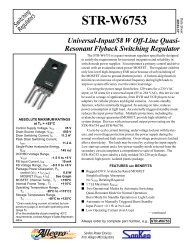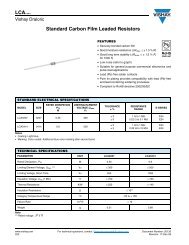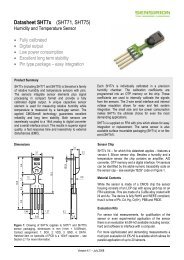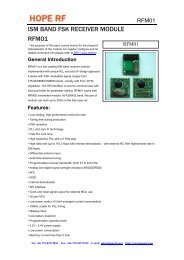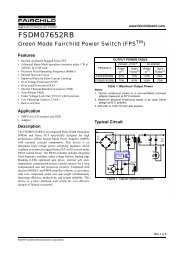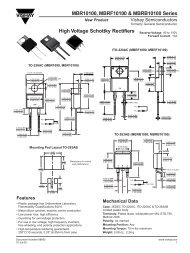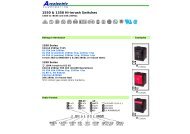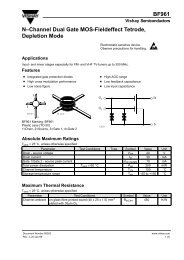LM3886 High-Performance 68W Audio Power Amplifier w Mute
LM3886 High-Performance 68W Audio Power Amplifier w Mute
LM3886 High-Performance 68W Audio Power Amplifier w Mute
You also want an ePaper? Increase the reach of your titles
YUMPU automatically turns print PDFs into web optimized ePapers that Google loves.
Definition of Terms<br />
Input Offset Voltage The absolute value of the voltage<br />
which must be applied between the input terminals through<br />
two equal resistances to obtain zero output voltage and current<br />
Input Bias Current The absolute value of the average of<br />
the two input currents with the output voltage and current at<br />
zero<br />
Input Offset Current The absolute value of the difference<br />
in the two input currents with the output voltage and current<br />
at zero<br />
Input Common-Mode Voltage Range (or Input Voltage<br />
Range) The range of voltages on the input terminals for<br />
which the amplifier is operational Note that the specifications<br />
are not guaranteed over the full common-mode voltage<br />
range unless specifically stated<br />
Common-Mode Rejection The ratio of the input commonmode<br />
voltage range to the peak-to-peak change in input<br />
offset voltage over this range<br />
<strong>Power</strong> Supply Rejection The ratio of the change in input<br />
offset voltage to the change in power supply voltages producing<br />
it<br />
Quiescent Supply Current The current required from the<br />
power supply to operate the amplifier with no load and the<br />
output voltage and current at zero<br />
Slew Rate The internally limited rate of change in output<br />
voltage with a large amplitude step function applied to the<br />
input<br />
Class B <strong>Amplifier</strong> The most common type of audio power<br />
amplifier that consists of two output devices each of which<br />
conducts for 180 of the input cycle The <strong>LM3886</strong> is a<br />
Quasi-AB type amplifier<br />
Crossover Distortion Distortion caused in the output<br />
stage of a class B amplifier It can result from inadequate<br />
bias current providing a dead zone where the output does<br />
not respond to the input as the input cycle goes through its<br />
zero crossing point Also for ICs an inadequate frequency<br />
response of the output PNP device can cause a turn-on<br />
delay giving crossover distortion on the negative going transition<br />
through zero crossing at the higher audio frequencies<br />
THD a N Total Harmonic Distortion plus Noise refers to<br />
the measurement technique in which the fundamental component<br />
is removed by a bandreject (notch) filter and all remaining<br />
energy is measured including harmonics and noise<br />
Signal-to-Noise Ratio The ratio of a system’s output signal<br />
level to the system’s output noise level obtained in the absence<br />
of a signal The output reference signal is either<br />
specified or measured at a specified distortion level<br />
Continuous Average Output <strong>Power</strong> The minimum sine<br />
wave continuous average power output in watts (or dBW)<br />
that can be delivered into the rated load over the rated<br />
bandwidth at the rated maximum total harmonic distortion<br />
Music <strong>Power</strong> A measurement of the peak output power<br />
capability of an amplifier with either a signal duration sufficiently<br />
short that the amplifier power supply does not sag<br />
during the measurement or when high quality external power<br />
supplies are used This measurement (an IHF standard)<br />
assumes that with normal music program material the amplifier<br />
power supplies will sag insignificantly<br />
Peak <strong>Power</strong> Most commonly referred to as the power output<br />
capability of an amplifier that can be delivered to the<br />
load specified by the part’s maximum voltage swing<br />
Headroom The margin between an actual signal operating<br />
level (usually the power rating of the amplifier with particular<br />
supply voltages a rated load value and a rated THD a N<br />
figure) and the level just before clipping distortion occurs<br />
expressed in decibels<br />
Large Signal Voltage Gain The ratio of the output voltage<br />
swing to the differential input voltage required to drive the<br />
output from zero to either swing limit The output swing limit<br />
is the supply voltage less a specified quasi-saturation voltage<br />
A pulse of short enough duration to minimize thermal<br />
effects is used as a measurement signal<br />
Output-Current Limit The output current with a fixed output<br />
voltage and a large input overdrive The limiting current<br />
drops with time once SPiKe protection circuitry is activated<br />
Output Saturation Threshold (Clipping Point) The output<br />
swing limit for a specified input drive beyond that required<br />
for zero output It is measured with respect to the supply to<br />
which the output is swinging<br />
Output Resistance The ratio of the change in output voltage<br />
to the change in output current with the output around<br />
zero<br />
<strong>Power</strong> Dissipation Rating The power that can be dissipated<br />
for a specified time interval without activating the protection<br />
circuitry For time intervals in excess of 100 ms dissipation<br />
capability is determined by heat sinking of the IC package<br />
rather than by the IC itself<br />
Thermal Resistance The peak junction-temperature rise<br />
per unit of internal power dissipation (units in CW) above<br />
the case temperature as measured at the center of the<br />
package bottom<br />
The DC thermal resistance applies when one output transistor<br />
is operating continuously The AC thermal resistance applies<br />
with the output transistors conducting alternately at a<br />
high enough frequency that the peak capability of neither<br />
transistor is exceeded<br />
<strong>Power</strong> Bandwidth The power bandwidth of an audio amplifier<br />
is the frequency range over which the amplifier voltage<br />
gain does not fall below 0707 of the flat band voltage<br />
gain specified for a given load and output power<br />
<strong>Power</strong> bandwidth also can be measured by the frequencies<br />
at which a specified level of distortion is obtained while the<br />
amplifier delivers a power output 3 dB below the rated output<br />
For example an amplifier rated at 60W with s 025%<br />
THD a N would make its power bandwidth measured as<br />
the difference between the upper and lower frequencies at<br />
which 025% distortion was obtained while the amplifier was<br />
delivering 30W<br />
Gain-Bandwidth Product The Gain-Bandwidth Product is<br />
a way of predicting the high-frequency usefulness of an op<br />
amp The Gain-Bandwidth Product is sometimes called the<br />
unity-gain frequency or unity-gain cross frequency because<br />
the open-loop gain characteristic passes through or crosses<br />
unity gain at this frequency Simply we have the following<br />
relationship A CL1 c f 1 e A CL2 c f 2<br />
Assuming that at unity-gain (A CL1 e 1 or (0 dB)) fu e fi e<br />
GBWP then we have the following GBWP e A CL2 c f2<br />
This says that once fu (GBWP) is known for an amplifier<br />
then the open-loop gain can be found at any frequency This<br />
is also an excellent equation to determine the 3 dB point of<br />
a closed-loop gain assuming that you know the GBWP of<br />
the device Refer to the diagram on the following page<br />
16


